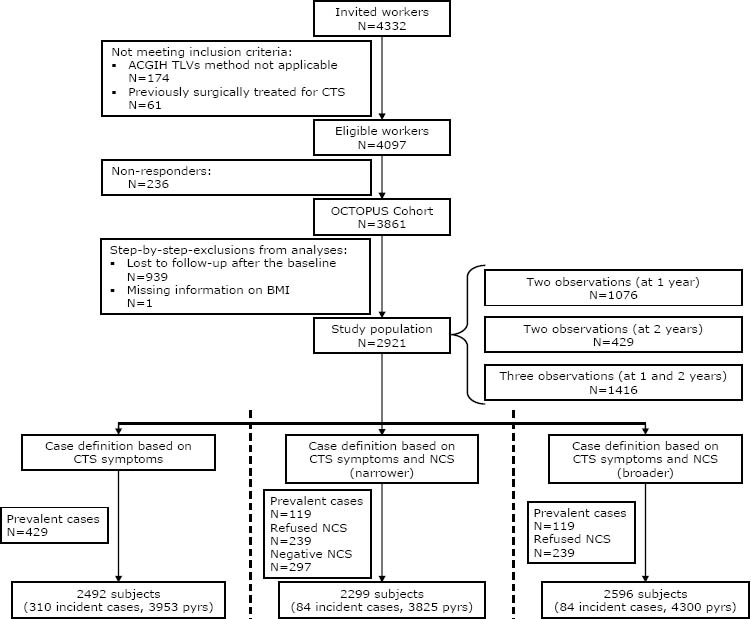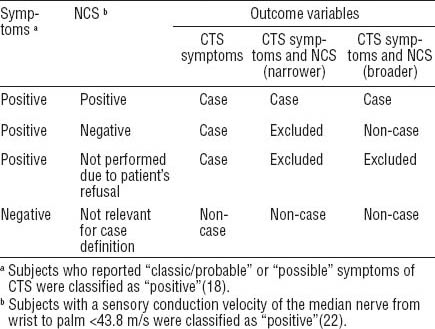Carpal tunnel syndrome (CTS) continues to be a major cause of disability and cost to society. The prevalence of CTS in the general population has been estimated as between 1– 5% (1, 2), while studies on its incidence have reported rates ranging from 0.5–3.8 per 1000 person-years (3–5). In Italy, a rate of 1.1 per 1000 person-years has been documented for surgically treated CTS (6).
Widely cited personal factors of CTS include gender, body mass index (BMI), height, marital status, familiar history, and other pathologies facilitating CTS onset (eg, rheumatoid arthritis, diabetes) (7, 8). There are a number of epidemiological studies that show a relationship between manual work (especially repetitive and forceful exertions) and CTS (9–11); however, many of these studies are cross-sectional and a causal relationship cannot therefore be concluded (9). Longitudinal studies are needed to investigate to what extent work is a primary cause of CTS.
A dose–response relationship for CTS and mechanical loads is supported by biomechanical models, laboratory studies and epidemiological studies. Early studies [eg, by Tanzer in 1959 (12)] demonstrated that certain postures of the wrist produce elevated pressure on the median nerve inside the carpal canal. Armstrong & Chaffin (13) proposed a pulley-belt model that showed the contact forces on the median nerve are related to tension in the finger flexor tendons and wrist flexion. Studies by Phalen (14) and Armstrong et al (15) showed fibrous connective tissue and thickening of the flexor synovia and the walls of arterioles inside the carpal tunnel in areas subjected to high contact stress tendon loads. Moore at al (16) showed that the tendon loads in the median nerve help explain the epidemiological findings of Silverstein et al (17) that CTS and hand–wrist tendonitis are related to repetitive work. Keir & Rempel (18) showed that deviation of the wrist from a neutral posture is associated with elevated fluid pressure inside the carpal tunnel. These studies provide support for the contribution of repetitive exertions, high hand forces and certain postures commonly involved in manual work to chronic tendon and nerve injuries in the wrist.
Based on available data, the American Conference of Governmental Industrial Hygienists (ACGIH) proposed a threshold limit value (TLV©) to determine unacceptable levels of hand activity and force for workers performing mono-task handwork (19). The ACGIH also proposed an action limit (AL) to trigger administrative controls. A mono-task job is defined as “… performing a similar set of motions or exertions repeatedly …” The ACGIH cites “assembly line” and “keyboard” work as specific examples of mono-task jobs. Both of these examples can include a broad range of possible exposures. There is no clear cut-off between mono- and multi-task jobs. We argue that the ACGIH TLV© applies to jobs in which there is a regular or predictable pattern of exertions over the course of each work shift.
The aim of this study was to investigate biomechanical load as a causal factor for CTS, using the ACGIH TLV© based on hand activity level (HAL) and normalized peak force (PF).
Methods
Setting, study design, and population
For this report we used data from the Occupational Carpal Tunnel Syndrome Observational Prospective Unified Study (OCTOPUS), a longitudinal study of different industrial and service worker groups started in 2000; Violante et al (8) has reported the materials and methods. In order to study the dose–response relationship between occupational risk factors and CTS, we aimed to enroll workers exposed to different biomechanical loads on the hand-wrist system. Hence, we established a heterogeneous dynamic cohort of persons employed in one of six selected factories [producing large (N=1) and small (N=1) domestic appliances, underwear (N=1), ceramic tiles (N=1), and shoes (N=2)] and workers employed in all municipal nursery schools of Bologna (Italy). All production workers and clerks (or similar white-collar workers) were invited to participate (N=4332), while managers and professionals were excluded from the study (number unknown). Eligibility criteria were (i) performing jobs for which the ACGIH TLV© could be evaluated from job observations, (ii) no history of surgical treatment for CTS, and (iii) not meeting the case definition for CTS at baseline.
The initial response proportion among invited and eligible workers was 94.3% (3861 out of 4097). Table 1 summarizes the distribution of the participants’ main characteristics according to follow-up status. Among workers with a complete follow-up, the proportion of women was slightly lower. Workers lost to follow-up after baseline presented a lower degree of exposure to biomechanical risk factors according to the ACGIH TLV© for HAL. Workers lost to follow-up after the first assessment was slightly more affected by CTS symptoms at baseline.
Table 1
Baseline characteristics of eligible subjects according to follow-up status. The OCTOPUS cohort, Italy, 2000–2003. [ACGIH=American Conference of Governmental Industrial Hygienists; AL=action limit; BMI=body mass index; CTS=carpal tunnel syndrome; SD=standard deviation; TLV=threshold limit value]

The flow through the study is reported in figure 1. Information on the disease status and personal characteristics/habits were collected directly in the workplaces annually. The first (baseline) assessment was performed in 2000–2001; the second (intermediate) assessment in 2001–2002; and the third (last) assessment in 2002–2003. Of the 3861 workers, 429 participated only in the first and the last assessment; these subjects were assumed to be healthy at the missed assessment and we considered them as contributing for two person-years each in our analyses.
The ACGIH TLV© for hand activity level
The ACGIH TLV© is based on HAL and PF, which are measured on scales of 0–10 where 0=no exposure and 10=the greatest exposure imaginable (19). The PF is the relative effort required for the most forceful part of the job. The ACGIH recommends that the peak value be based on a 90th percentile. The 90th percentile is more stable than the maximum value that often varies among the same sequences of exertions. The HAL takes into consideration exertion frequency and recovery time between successive exertions and is an average for the entire job. HAL and PF are combined together by taking the ratio PF/(10-HAL) (20). The calculated value is evaluated against ACGIH reference values (the AL and the TLV).
A worker is considered to be exposed above the AL if his/her ratio PF/(10-HAL) is ≥0.56; if the ratio is >0.78 the exposure is considered to exceed the TLV (20). Hence, three categories of biomechanical load on the hand-wrist system can be identified by the ACGIH method: (i) loads below the AL (herein, referred to as “acceptable loads”); (ii) loads between AL and TLV (“borderline loads”); (iii) loads above TLV (“unacceptable loads”).
Data collection
Lists of jobs were provided by the participating companies and the nursery schools for each study site. A walk-through inspection was performed at each site to verify its suitability for study and to develop a data collection plan. A team of eight independent observers, working in pairs as described by Ebersole et al (21), assessed ACGIH HAL and PF exposures. All observers were experienced in occupational ergonomic analysis techniques and blinded to health outcomes. For each job, two (or more) investigators observed all normal job activities and independently estimated the overall HAL and PF for the hand with the highest exposure. The investigators then compared and discussed their observations and attempted to achieve agreement within one point on the scale of ten points. Each job was assigned a single exposure value based on the averages of the final ratings following the discussion by the observers as described by Ebersole et al (21). In most cases, the raters achieved agreement within one point. Ratings were not performed for each hand separately. In many cases, the workers could choose which hand they used based on personal preference, eg, right- or left-handedness. Plant representatives were consulted to confirm that there were no abnormal conditions (eg, equipment problems, new workers, etc) that might influence the exposure assessment. All available jobs were assessed at each site.
Exposure to hand–arm vibrations (HAV) was assessed in terms of presence or absence; workers performing jobs in which any vibratory tools were used for every work-cycle, independently of total time of usage, were considered exposed to HAV.
Biomechanical exposure assessment was not performed again after 2001 except in the factory that produced large domestic appliances, where a big fire broke out in 2001 and destroyed one of the assembly lines. Assembly activities were then assessed in 2003 when the line restarted. The average biomechanical loads were assumed to be constant during the study period for all jobs. There were no known changes in production at participating companies between 2000–2003. The ACGIH TLV© for HAL was primarily intended for mono-task jobs (19); therefore activities that did not include regular or predictable patterns of exertions over the course of each work shift (ie, maintenance or cleaning activities, electricians) were excluded. At each assessment, workers were asked about changes in their jobs; thus, exposure to biomechanical risk factors, according to the jobs performed, was separately recorded for each follow-up period.
Personal information was collected with standardized questionnaires administered at every assessment by a trained physician. Possible covariates to be considered in multivariate analyses were selected a priori and included: sex, age, BMI, height, wrist circumference, smoking status, alcohol consumption, family history of CTS among first-degree relatives, personal history of wrist fractures, personal history of diseases predisposing to CTS (diabetes mellitus, amyloidosis, gout, progressive systemic sclerosis, rheumatoid arthritis, systemic lupus erythematosus, thyroid disorders, tendonitis of the finger flexors, and chronic renal failure), and exposure to HAV.
Case definitions and outcomes
Our case definitions were established at an individual level; a worker was considered to be affected by CTS if at least one hand met the case definition of interest. We considered two different case definitions: (i) presence of CTS symptoms in the 30 days before the interview; and (ii) presence of CTS symptoms and slowing of sensory conduction velocity of the median nerve from wrist to palm.
The definition of symptoms followed the classification scheme for assessment of symptom qualities proposed in the consensus criteria for the classification of CTS in epidemiologic studies (22). Information was collected with a structured questionnaire including the Katz hand diagram (23); subjects that reported numbness, tingling, burning, or pain in ≥1 of digits 1, 2, or 3 (“classic/probable” or “possible” symptoms of CTS) were classified as symptomatic (22).
Experienced electro-diagnostic testers performed nerve conduction studies (NCS), as described elsewhere (8). The sensory conduction velocity of the median nerve from wrist to palm was classified as “slowed” if it fell below the lower 99% confidence limit (43.8 m/s) of the electro-diagnostic reference values described by Kimura (24). For the case definition based on symptoms and NCS findings, we constructed two different outcome variables as presented in table 2, referred to as “narrower” and “broader”. The “narrower” outcome variable did not consider symptomatic subjects with normal conduction studies, while the “broader” variable included them as “non cases”. We intended the “narrower” variable as the main outcome measure based on NCS, while the “broader” variable served as a sensitivity analysis.
Statistical analysis
Summary statistics are expressed as numbers (percentages), mean (standard deviation), or median (interquartile range) as appropriate. The correlation between variables was studied using Spearman’s rank correlation coefficient (Spearman’s rho). The associations between biomechanical exposures and CTS risk were assessed by calculating incidence rate ratios (IRR) and relative 95% confidence Intervals (95% CI) with multivariate Poisson regression models. HAL and PF were considered time-varying exposure and, for each person-year, the exposure was classified independently. Of note, among the subjects that contributed two person years to the analysis, only 18 workers changed their ACGIH exposure class in the second year. Covariates to be included in the multivariate models were selected with a “significance-test-of-the-covariate” strategy (25). We started from a model which included all the pre-selected baseline covariates alongside a variable with two degrees of freedom for the three ACGIH categories; we then performed a backward deletion, retaining the variables that reached the statistical significance level of P<0.1 at the likelihood ratio test.
Only subjects with complete information on selected covariates entered the analyses (list-wise deletion). After the selection of the covariates, possible nonlinear associations between continuous predictors and outcome were explored using multivariate fractional polynomials (26); we did not find any evidence of non-linearity of the association with the outcome for the two continuous variables (ie, age and BMI) included in the final model.
The main exposure variable under investigation was constructed according to the three ACGIH categories; to explicitly study the individual contribution of HAL and PF in predicting the risk of CTS, we also created Poisson regression models that included one of the two parameters at a time or the two parameters together. The robust Huber-White “sandwich” estimator of variance clustered on the 7 enterprises was used in our analyses (27).
All the analyses were performed using Stata 11.1 SE (Stata Corp, College Station, TX, US). All tests were 2 sided.
Results
There were 4097 workers eligible for the cohort. Of these, 236 (5.8%) were non-responders, 2194 (53.6%) had a complete follow-up, 939 (22.9%) were lost after baseline, and 728 (17.8%) were lost after intermediate assessment. During the second assessment, 354 new workers entered the dynamic cohort. One subject with missing information on a possible confounder (BMI) was excluded from the analyses.
Among the 3860 subjects with complete information at baseline, the mean age was 38.1 [standard deviation (SD) 9.5] years, the mean BMI was 23.8 (SD 3.9) kg/m2, and median current job seniority was 7 [inter-quartile range (IQR) 2–15] years. The subjects consisted of 2599 (67.3%) women [mean age 39.2 (SD 9.5) years, mean BMI of 23.2 (SD 4.1) kg/m2, and median current job seniority of 8 (IQR 2–17) years] and 1261 (32.7%) men [mean age 35.6 (SD 9.2) years, mean BMI of 25.1 (SD 3.3) kg/m2, and median current job seniority of 6 (IQR 2–11) years]. A total of 429 subjects were symptomatic at baseline; among them, 119 had a slowing of sensory conduction velocity of the median nerve. Baseline characteristics according to follow-up status are presented in table 1.
All symptomatic subjects (at baseline or during follow-up) were invited to undergo NCS; 239 (32.3%) workers refused to undergo examination. During the study period, 310 workers presented incident symptoms; 84 of them had a positive electroneurographic testing.
The distribution of the study population (N=2921) at baseline according to HAL, PF and gender is shown in figure 2. The distribution of PF appear to be more heterogeneous among men, as most women presented values ranging from 4–5. Overall, a moderate correlation (Spearman’s rho 0.42) was found between the values of HAL and PF at the baseline; the correlation was stronger among women (Spearman’s rho 0.52) than men (Spearman’s rho 0.27).
Figure 2
Distribution of the 2921 participants by gender, hand activity level and normalized peak force. The OCTOPUS cohort, Italy, 2000-2003 (Circle sizes are proportional to the number of workers).
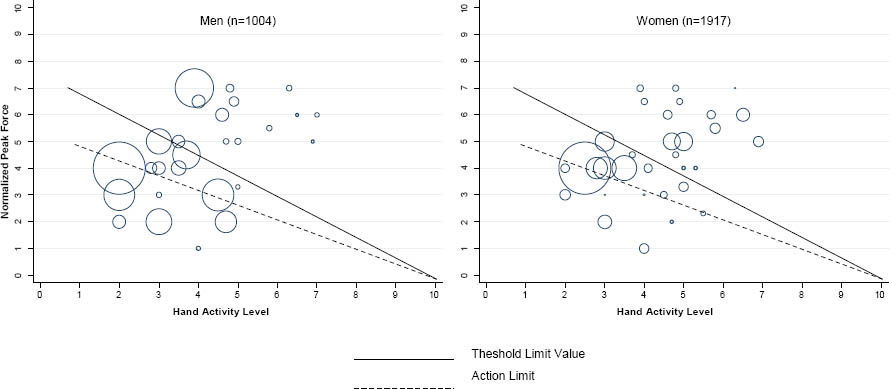
After preliminary analysis, gender, age, BMI, and presence of pathologies predisposing to CTS onset were retained as covariates in multivariate models for all three outcome variables. Of note, exposure to HAV did not reach the predefined significance level for the selection of covariates (P<0.1) for any of the outcome variables. Table 3 presents the estimates for the multivariate Poisson models selected to study the relationship between ACGIH categories and risk of CTS. Estimates for the two case definitions are consistent, even if the rate ratios for the case definition based on CTS symptoms and NCS [adjusted IRR between AL and TLV 1.95 (95% CI 1.21–3.16); above TLV 2.70 (95% CI 1.48–4.91)] are approximately 20–30% lower than those for the case definition based only on symptoms [adjusted IRR between AL and TLV 2.43 (95% CI 1.77–3.33); above TLV 3.32 (95% CI 2.34–4.72)]. Nevertheless, both multivariate models in table 3 present a dose–response relationship between the ACGIH classification and the risk of CTS. Among personal characteristics, female gender appears as a strong determinant of CTS in both case definitions, with a risk of disease more than doubled in comparison to males. The effect of BMI and age seemed stronger when studying CTS diagnosed with NCS.
Table 3
Results from multivariate Poisson regression models including exposure classified according to American Congress of Government Industrial Hygienists (ACGIH) alongside selected covariates. The OCTOPUS cohort, Italy, 2000–2003. [AL=action limit; BMI=body mass index; CTS=carpal tunnel syndrome; IRR=incidence rate ratio; NCS=nerve conduction studies; TLV=threshold limit value; 95% CI=95% confidence interval].
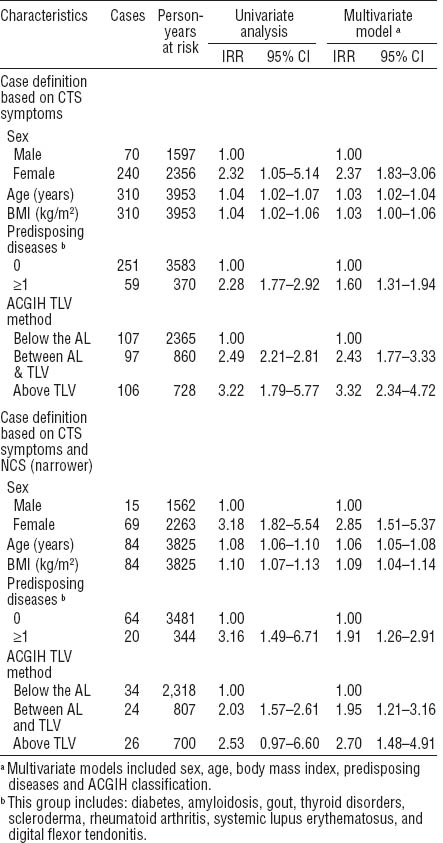
In table 4, we report the IRR of CTS and 95% CI from multivariate Poisson regression models using 4 different metrics for occupational exposure; the estimates are presented for all three outcome variables. For the first two outcome variables, exposure estimates classified according to ACGIH are derived from the same models presented in table 3. When adopting the broader case definition based on symptoms and NCS (right column of table 4), the estimates appeared lower than those estimated for the other case definitions. Results from Poisson models including only HAL and PF, respectively, appeared associated with CTS for all the outcome variables. However, when considering models with both HAL and PF, HAL was still a strong predictor of the outcome variables while the estimates for PF considerably decreased. Also, for all case definitions, estimates for HAL were more precise in models not including PF.
Table 4
Estimates a from 12 Poisson regression models adopting different metrics for occupational exposure to biomechanical risk factors. The OCTOPUS cohort, Italy, 2000–2003. [ACGIH=American Congress of Government Industrial Hygienists; AL=action limit; CTS=carpal tunnel syndrome; HAL=hand activity level; IRR=incidence rate ratio; NCS=nerve conduction studies; PF=peak force; TLV=threshold limit value; 95% CI=95% confidence interval]
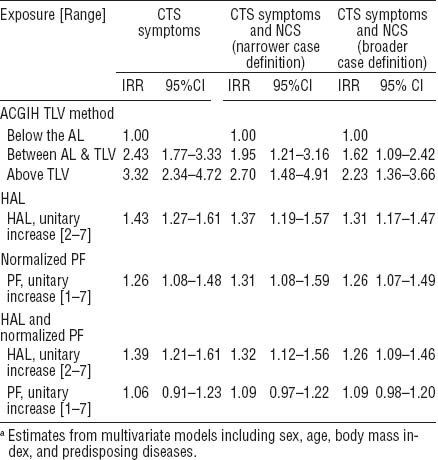
Discussion
ACGIH TLV© for HAL predicted a dose–response relationship for the incidence of CTS in the OCTOPUS cohort. The ACGIH formula used to determine whether the exposure exceeds the AL or TLV (ie, ratio=PF/(10-HAL)) is calculated giving equal weights to HAL and PF; if our findings are confirmed in other studies, a different formula that gives a higher weight to HAL should be considered. In addition, our cohort presented an appreciable increase in risk of CTS for subjects below the TLV but above the AL; this element might suggest that the current cut-off value used for the TLV (ie, ratio ≥0.78) might not be sufficiently protective and some workers could be at risk even for exposures below the TLV. This work supports a dose–response relationship between the incidence of CTS and the biomechanical loads associated with increasing HAL and PF (table 4). CTS incidence was slightly more sensitive to HAL than PF. Previous studies have also found CTS to be more sensitive to repetitiveness than force (17, 28, 29). This may imply that the recovery time between successive tendon loads is more important than the magnitude of the loads at normal work rates and intensities. This finding may also be due to inaccurate estimates of PF from observations. Studies by Ebersole et al demonstrate that inter-rater variations are greater for PF than HAL (30).
As regards personal characteristics, our results are consistent with the current knowledge on CTS. The presence of gender differences for CTS has been reported several times in the medical literature (eg, 3–6). However, it has been hypothesized that gender could “mask” exposure differences between men and women (31, 32); in particular, gender could be a proxy of exposure when occupational exposure to biomechanical risk factors is not collected or is highly misclassified. In our longitudinal study, the occupational biomechanical exposure of the hand–wrist system was carefully assessed according to the ACGIH recommendations, and we found an important increase in risk of CTS for women. Age is a well-known predictor of the disease (4, 5, 33), alongside BMI (7, 8, 34).
Figures obtained with the case definition based only on symptoms were consistent with those obtained when also considering NCS. This finding is in line with the results of a recent systematic review that highlighted that complex case definitions (eg, based on examinations) for upper-limb disorders (including CTS) yield similar associations with occupational determinants to those obtained using simple case definitions based on symptoms (35). Moreover, findings from a review on the case definitions for CTS in epidemiological studies suggested the possibility of comparing the results obtained in studies adopting various case definitions of CTS, based on different combinations of symptoms, clinical examination, and/or NCS (36).
Study strengths and limitations
Our study is one of the very few prospective validations of observational methods for the assessment of biomechanical exposures at work (37). To our knowledge, the OCTOPUS cohort is larger than any other previously published occupational cohort designed to study the association between CTS and biomechanical risk factors. One of the strengths of this study is the direct assessment of HAL and PF for each job. Moreover, information on possible confounders was collected prospectively by direct interviews.
Regarding participation in the study, on the one hand, the initial response proportion was satisfactory (>94%), on the other hand, loss to follow-up was not negligible and attrition bias could represent a concern. A comparison of baseline characteristics in the OCTOPUS cohort highlighted that women tended to be lost to follow-up more than men.
However, we should consider that loss of subjects to follow-up could have been mainly determined by workers who changed their employment status, were from factories that closed down (the underwear factory), or were temporarily absent from work (eg, due to illness, parental leave, or other employee benefits). All the aforementioned conditions seem to be weakly related to CTS. Hence, we hypothesize that loss to follow-up should not substantially bias our results. Another possible limitation of our study is that the assessment of biomechanical risk factors was performed only at baseline. However, there were no changes in production technologies or volumes in the seven participating enterprises during the study period. Therefore, misclassification of biomechanical exposure due to changes in jobs should be negligible.
Since exposure assessment was not feasible for multi-task jobs, only activities that included regular or predictable patterns of exertions over the course of each work shift were assessed. Thus, our study is not able to provide information for multi-task manual jobs (eg, maintenance workers, cleaners, janitors). In our analysis, 429 workers that participated in the last assessment, but missed the intermediate one, were assumed to contribute for two person-years each. As 46 of them were considered to be affected by CTS for the case definition based on symptoms and 5 of them met the case definition based on symptoms and NCS, person-years in our study could be slightly overestimated, and a tiny bias in point estimates could be present. In the OCTOPUS cohort, HAV were registered as a dichotomous exposure; no measurements of frequency or acceleration were collected. Hence, we were not able to study HAV properly as a risk factor for CTS and we only explored the exposure to HAV as a possible confounder of the relationship between the ACGIH classification and the risk of CTS.
Concluding remarks
Based on the measure of the HAL and the PF, the ACGIH TLV© for HAL enables the classification of workers in three categories (below the AL, between the AL and the TLV, above the TLV). The HAL is based on the frequency of exertions and the duty cycle (distribution of work and recovery periods), while the PF is the peak effort exerted by the hand during each regular work cycle. We found a dose–response relationship between biomechanical exposure classified according to ACGIH and incidence of CTS. According to the ACGIH, the TLV should not be exceeded; also, the AL is considered the level that triggers general controls, including surveillance. However, a non-negligible risk was found in our study for workers exposed between the AL and the TLV; hence, the current limits – AL and TLV – might not be sufficiently protective for some workers. The apparently different strength of association of HAL and PF with CTS found in our study deserves further investigation.


